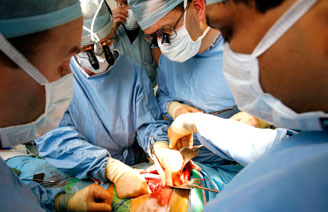
levels of trauma:
- Level I trauma centers provide multidisciplinary treatment and specialized resources for trauma patients and require trauma research, a surgical residency program and an annual volume of 600 major trauma patients per year.
- Level II trauma centers provide similar experienced medical services and resources but do not require the research and residency components. Volume requirements are 350 major trauma patients per year.
- Level III trauma centers are smaller community hospitals that have services to care for patients with moderate injuries and the ability to stabilize the severe trauma patient in preparation for transport to a higher level trauma center. Level III trauma centers do not require neurosurgical resources.
- Level IV trauma centers are able to provide initial care and stabilization of traumatic injury while arranging transfer to a higher level of trauma care.
Trauma Care Unit
Major trauma describes serious injuries that are life-changing and could result in death or serious disability, including head injuries, severe wounds and multiple fractures.
Major trauma centres are set up to provide specialised trauma care and rehabilitation. They are hubs that work closely with local trauma units.
Once patients arrive at hospital, they will immediately undergo a full assessment by a consultant-led trauma team trained to deal with these types of injuries.
Patients who have suffered a severe injury often need complex reconstructive surgery and care from many professionals, such as physiotherapists, occupational therapists, and speech and language therapists. Psychological support for patients and their families is also very important.Many patients need a personalised rehabilitation programme to help them return to an active life, which can take many months.
Research shows that in states where there is a trauma system in place, the death rate is drastically reduced. A trauma system, unlike a trauma center, involves the integration of many additional services including Emergency Medical Services (EMS), rehabilitation facilities and trauma prevention organizations.
What does good trauma care look like?
Good trauma care involves getting the patient to the right place at the right time for the right care. This means:

- Having the seriousness of the injury identified as early as possible, ideally at the scene of the incident.
- Investigations such as CT scanning should take place immediately on arrival at the first hospital.
- If the injury requires specialist care, the patient should be moved to a major trauma centre as quickly as possible.
- Patients should have access to an appropriate programme of rehabilitation to assist their recovery.

